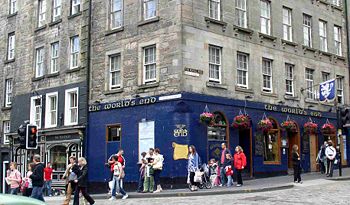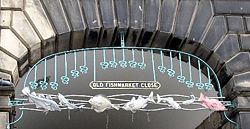Royal Mile
The Royal Mile is the main street in Edinburgh's Old Town. It runs steadily downhill from Edinburgh Castle to the Royal Palace of Holyroodhouse at the foot of Arthur's Seat, a distance of just over a mile. The New Scottish Parliament building is at the bottom of the Royal Mile, opposite the Palace.
All along its way, from the Castle Esplanade, Castlehill, Lawnmarket, High Street, Canongate to Abbey Strand, The Royal Mile has many features of historical interest, making it the focus of tourist attention in the city. During the Fringe Festival in July of each year, the Royal Mile is also the focus of street performances and previews of the many shows that are part of the festival. St Giles' Cathedral, the High Kirk of Edinburgh, is in Parliament Square on the Royal Mile; its four main pillars are dated to 1190. Just outside the kirk, inset into the pavement is a cobblestone mosaic in the shape of a heart - the "Heart of Midlothian", that marked the entrance to Edinburgh's 15th century tolbooth. Originally an office for collecting tolls, the tolbooth became a prison, with a scaffold outside. Prisoners would spit on the door of the tolbooth and this tradition is still preserved as the custom of spitting on the Heart of Midlothian. Amongst those publicly hanged there is Thomas Aikenhead (c. 1678 - 1697), a student who was the last person in Britain to be executed for blasphemy. His indictment read:
... the prisoner had repeatedly maintained... that theology was a rhapsody of ill-invented nonsense, patched up partly of the moral doctrines of philosophers, and partly of poetical fictions and extravagant chimeras...That the Holy Scriptures were stuffed with such madness, nonsense, and contradictions, that he admired the stupidity of the world in being so long deluded by them...from the indictment of Thomas Aikenhead
The Royal Mile contains entrances to many small alleys and closes, with picturesque names and often interesting histories. Mary King Close[1] was one such Close. In 1753, development of a new building, the Royal Exchange (designed by John Adam) on the Royal Mile involved building over Mary King Close. The Royal Exchange is now the City Chambers – the administrative centre of the City, and what was once the street level of Mary King Close remained intact, though now completely overbuilt. The Close was forgotten, until in 1928 a council workman discovered an entrance to it. The Close is now open to visitors and is a major tourist attraction, encouraged by convenient tales of haunting.
|
"On Saturday evening I found myself at the market, which is then held in High-street and the Netherbow, just as you enter the Canongate, and where the old wooden effigy of John Knox, with staring black eyes, freshly painted every year, stands in its pulpit, and still seems preaching to the crowd. Hither a throng of sickly-looking, dirty people, bringing with them their unhealthy children, had crawled from the narrow wynds or alleys on each side of the street. We entered several of these wynds, and passed down one of them, between houses of vast height, story piled upon story, till we came to the deep hollow of the Cowgate. Children were swarming in the way, all of them, bred in that close and impure atmosphere, of a sickly appearance, and the aspect of premature age in some of them, which were carried in arms, was absolutely frightful. "Here is misery," said a Scotch gentleman, who was my conductor. I asked him how large a proportion of the people of Edinburgh belonged to that wretched and squalid class which I saw before me. "More than half," was his reply. William Cullen Bryant July 17, 1845. [2] |
From Palace to Castle
Abbey Strand
- the Royal Palace of Holyroodhouse (Holyrood Palace; an official residence of the Queen, but open to the public when she is not in residence. The Palace was started in 1501 and completed by Charles II.
- Adjacent to Holyrood Palace, the Queen's Gallery[3] displays exhibitions of art from the Royal Collection.
- Opposite the Queen's Gallery is the New Scottish Parliament building.
Canongate
According to legend, on 14 September 1128 King David I was attacked by a stag while out hunting in the forest of Drumselch, which then lay below Arthur's Seat. Thrown from his horse, he raised his arms to protect himself, but instead of its antlers he was confronted by a cross (or rood). He established a monastery at the site of this miraculous escape, (which was to become the Augustine Holyrood Abbey), and he granted a charter to the adjacent burgh which was to become Canongate. The walk from the Abbey to the entrance to the walled city became known as 'Canon's Gait' or Canongate. The arms of the burgh include a stag's head surmounted by a cross. By 1663 the burgh of Canongate had six parishes; its Tolbooth, built in 1591, housed the burgh's Council Chamber, court and later a prison. In 1865 it was subsumed into the City of Edinburgh.
- Canongate Kirk. The Canongate Kirkyard, just behind the Tolbooth, contains the graves of Adam Smith (1723-90), author of The Wealth of Nations, the painter Hugh 'Greek' Williams (1773-1829),
and the poet Robert Fergusson (1750-74), whose epitaph reads:
- No sculptured marble here, nor pompous lay,
- No storied Urn, nor animated Bust;
- This simple Stone directs Pale Scotia's way
- To pour her Sorrows o'er her poet's Dust
Outside the Kirk is a statue of Robert Ferguson who is said to have inspired Robert Burns.
- The Museum of Edinburgh [4], formerly known as Huntly House, occupies 16th and 17th century buildings. Exhibits include:the feeding bowl and collar belonging to Greyfriars Bobby; the National Covenant, the petition for religious freedom signed by Scotland’s Presbyterians in 1638; and the original plans for Edinburgh’s New Town drawn by architect James Craig.
- Jenny Ha's public house
- Whiteford House
- The World's End public house was the site of the last reported sighting of two young women, murdered in 1977. In 2007, a convicted killer and sex offender was brought to trial on DNA evidence, but the trial collapsed amidst controversy[5]
High Street
- The Tron Kirk, at the intersection of South Bridge and the Royal Mile, is a visitor centre for the Old Town. A "tron" was a public weighbridge, and the Kirk, built in 1637,was named after a salt tron than once stood on that site.
- The Museum of Childhood[6], displays toys, costumes, books, dolls and games.
- John Knox House consists of two town houses (or "lands") with the earlier part constructed about 1470 as part of the redevelopment of the city's walls. John Knox was a Protestant leader born between 1505 and 1515, who died at Edinburgh on 24 November, 1572. He is a controversial figure in Scotland's history, who was appointed minister of the Church of St. Giles' when the Reformed Protestant religion was ratified by law in Scotland in 1560.
- Lady Stair’s House/Writer’s Museum displays manuscripts, relics and memorabilia of Robert Burns, [Sir Walter Scott]] and R.L. Stevenson.
- St Giles' Kirk, the High Kirk of Presbyterianism in Scotland
- The Heart of Midlothian
- The Council Chambers* Parliament Square is named after the old Parliament House which housed both the law courts and the Parliament of Scotland until 1707 when it was adjourned by the Act of Union. Parliament House is now the home of the Court of Session, Scotland's supreme civil court.
- "The People's Story" [7] is housed in the late 16th century Canongate Tolbooth opposite the Museum of Edinburgh. ' The People's Story ' uses oral history, reminiscence, and written sources to tell the story of the lives, work and leisure of the ordinary people of Edinburgh, from the late 18th century to the present.
- The Law Courts
- Mary King Close [8]
- Statue of David Hume, philosopher
Lawnmarket
The Lawnmarket(the name is a corruption of 'land market'), which connects Castlehill to the west end of the High Street, was once the site of the city's linen market, established there by James III in 1477.The Lawnmarket has the best preserved examples of close, courtyard and 'land' developments in the city, including James Court, with Lady Stair's House and which is fronted by Gladstone's Land; Riddle's Court, which includes Baillie McMorran's House; Mylne's Court, now residential accomodation for postgraduate students at The University of Edinburgh and which gives access to the Assembly Hall of the Church of Scotland; and Riddle's Court. Major Thomas Weir (1599-1670), who confessed to sorcery and incest and was sentenced to be strangled and burned at the stake, lived nearby in West Bow with his sister Jean, who was convicted of witchcraft and hanged in the Grassmarket.
- Deacon Brodie's Tavern on the Royal Mile perpetuates the memory of Deacon William Brodie (hanged in 1788). Brodie led a double life; he was a qualified wood-worker and a pillar of the community who is known to have met Robert Burns and the painter Sir Henry Raeburn, but also a heavy gambler with five illegitimate children. He began to take wax impressions of the keys to the houses in which he was working, later returning at night to rob them. His double life is said to have been the inspiration for Robert Louis Stevenson's story of "Dr Jekyll and Mr Hyde." Brodie's Close off the Royal Mile is named after his father.
- Gladstone’s Land. Owned by the National Trust for Scotland, this is the 17th century tenement home of an affluent merchant, Thomas Gledstanes. The house is decorated authentically, and two floors are furnished to give visitors an impression of life in Edinburgh's Old Town 300 years ago. Notable features include the painted ceilings and a reconstructed shop booth with replicas of 17th-century goods.[9]
At the corner of Lawnmarket and George IV bridge a brass plaque marks the site of the last public execution in Edinburgh. On 21st June, 1864, George Bryce ("The Ratho murderer") was hanged for the murder of Jane Seaton.
Castle Hill
- The Scottish Whiskey Centre
- The Witchery, located in a 16th-century building at the gates of Edinburgh Castle, this is one of Edinburgh's leading restaurants [10]
- The Camera Obscura and World of Illusions [11]
- Edinburgh Castle One of the UK's leading tourist attractions, the Castle's features include St Margaret's Chapel - Edinburgh's oldest building, dating from the 1100s; Crown Square - the main courtyard, developed in the 15th century; The Great Hall with a hammerbeam roof built by James IV; The Half Moon Battery, from the late 16th century; and The Scottish National War Memorial added after the First World War. The Edinburgh Military Tattoo[12] is held every Summer in the esplanade outside the Castle.
References
- ↑ Mary King Close
- ↑ Letters of a Traveller by William Cullen Bryant
- ↑ The Queen's Gallery
- ↑ The Museum of Edinburgh
- ↑ BBC News: Wold's end murders
- ↑ The Museum of Childhood
- ↑ The People's Story
- ↑ Mary King Close
- ↑ Gladstone's Land
- ↑ The Witchery
- ↑ Camera Obscura & World of Illusions
- ↑ Edinburgh Military Tattoo



